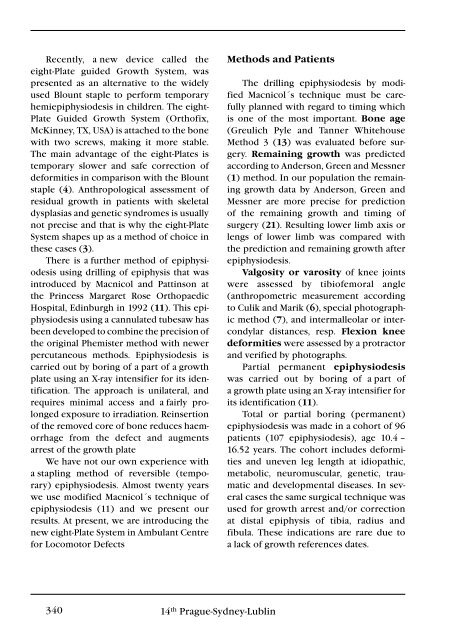3+4+Supplementum/2012 - Společnost pro pojivové tkáně
3+4+Supplementum/2012 - Společnost pro pojivové tkáně
3+4+Supplementum/2012 - Společnost pro pojivové tkáně
- TAGS
- www.pojivo.cz
Create successful ePaper yourself
Turn your PDF publications into a flip-book with our unique Google optimized e-Paper software.
Recently, a new device called the<br />
eight-Plate guided Growth System, was<br />
presented as an alternative to the widely<br />
used Blount staple to perform temporary<br />
hemiepiphysiodesis in children. The eight-<br />
Plate Guided Growth System (Orthofix,<br />
McKinney, TX, USA) is attached to the bone<br />
with two screws, making it more stable.<br />
The main advantage of the eight-Plates is<br />
temporary slower and safe correction of<br />
deformities in comparison with the Blount<br />
staple (4). Anthropological assessment of<br />
residual growth in patients with skeletal<br />
dysplasias and genetic syndromes is usually<br />
not precise and that is why the eight-Plate<br />
System shapes up as a method of choice in<br />
these cases (3).<br />
There is a further method of epiphysiodesis<br />
using drilling of epiphysis that was<br />
introduced by Macnicol and Pattinson at<br />
the Princess Margaret Rose Orthopaedic<br />
Hospital, Edinburgh in 1992 (11). This epiphysiodesis<br />
using a cannulated tubesaw has<br />
been developed to combine the precision of<br />
the original Phemister method with newer<br />
percutaneous methods. Epiphysiodesis is<br />
carried out by boring of a part of a growth<br />
plate using an X-ray intensifier for its identification.<br />
The ap<strong>pro</strong>ach is unilateral, and<br />
requires minimal access and a fairly <strong>pro</strong>longed<br />
exposure to irradiation. Reinsertion<br />
of the removed core of bone reduces haemorrhage<br />
from the defect and augments<br />
arrest of the growth plate<br />
We have not our own experience with<br />
a stapling method of reversible (temporary)<br />
epiphysiodesis. Almost twenty years<br />
we use modified Macnicol´s technique of<br />
epiphysiodesis (11) and we present our<br />
results. At present, we are introducing the<br />
new eight-Plate System in Ambulant Centre<br />
for Locomotor Defects<br />
340 14 th Prague-Sydney-Lublin<br />
Methods and Patients<br />
The drilling epiphysiodesis by modified<br />
Macnicol´s technique must be carefully<br />
planned with regard to timing which<br />
is one of the most important. Bone age<br />
(Greulich Pyle and Tanner Whitehouse<br />
Method 3 (13) was evaluated before surgery.<br />
Remaining growth was predicted<br />
according to Anderson, Green and Messner<br />
(1) method. In our population the remaining<br />
growth data by Anderson, Green and<br />
Messner are more precise for prediction<br />
of the remaining growth and timing of<br />
surgery (21). Resulting lower limb axis or<br />
lengs of lower limb was compared with<br />
the prediction and remaining growth after<br />
epiphysiodesis.<br />
Valgosity or varosity of knee joints<br />
were assessed by tibiofemoral angle<br />
(anthropometric measurement according<br />
to Culik and Marik (6), special photographic<br />
method (7), and intermalleolar or intercondylar<br />
distances, resp. flexion knee<br />
deformities were assessed by a <strong>pro</strong>tractor<br />
and verified by photographs.<br />
Partial permanent epiphysiodesis<br />
was carried out by boring of a part of<br />
a growth plate using an X-ray intensifier for<br />
its identification (11).<br />
Total or partial boring (permanent)<br />
epiphysiodesis was made in a cohort of 96<br />
patients (107 epiphysiodesis), age 10.4 –<br />
16.52 years. The cohort includes deformities<br />
and uneven leg length at idiopathic,<br />
metabolic, neuromuscular, genetic, traumatic<br />
and developmental diseases. In several<br />
cases the same surgical technique was<br />
used for growth arrest and/or correction<br />
at distal epiphysis of tibia, radius and<br />
fibula. These indications are rare due to<br />
a lack of growth references dates.

















